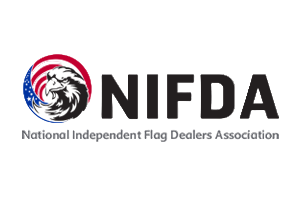FAQs about American Flag + Alaska Flags
What materials are best for American Flag + Alaska flags?
Alaska flag material guide: Choose 200-denier nylon for sheltered neighborhoods (Anchorage bowls, treed sites)—it lifts easily in light air and dries fast after snow—while 2-ply woven polyester excels in windy, coastal, or exposed locations (Cook Inlet, Aleutians, hillside homes). For freeze/thaw and gales, insist on a reinforced canvas header, brass grommets, lock-stitched seams, and extra fly-end stitching. Nylon stays crisp about 3–6 months in typical use; polyester usually outlasts it where winds are frequent. Tip: rotate a spare and lower ahead of blizzards.
What size American Flag + Alaska flag should I buy?
U.S. & State Flag Size Pairings (3×5 to 5×8)
| U.S. Flag | Typical Pole Height | Same Pole (state flag below U.S.) | Separate Poles (side-by-side) | Notes |
|---|---|---|---|---|
| 3′ × 5′ | 15–20 ft | 2′ × 3′ or 3′ × 5′* | 3′ × 5′ | State ≤ U.S. |
| 4′ × 6′ | 20–25 ft | 3′ × 5′ | 4′ × 6′ | Equal OK on separate poles |
| 5′ × 8′ | 25–30 ft | 4′ × 6′ | 5′ × 8′ | Use heavier fabric in high wind |
* Same-size (3′×5′ + 3′×5′) on one pole is acceptable—U.S. must remain at the peak.
Quick Rules
- Nothing flies above the U.S. flag.
- On separate poles, place the U.S. flag on its own right (observer’s left) and at the same height or higher.
- Half-staff (one pole): raise U.S. to peak first, then lower to half; state flag stays below it.
How long will this American Flag + Alaska flag last?
Outdoor lifespan depends on wind and sun. In windy or coastal areas, polyester usually outlasts nylon. Rotate a spare and trim early frays to extend life..
Can I wash my American Flag + Alaska flag?
Yes. Most nylon and polyester flags can be hand-washed with mild soap and water. Allow to air dry fully before reuse.
What’s unique about the American Flag + Alaska flag design?
National flag of American Flag + Alaska; colors and layout follow the official national design.
Any special protocol for displaying American Flag + Alaska flags?
- Same pole (same halyard): The U.S. flag goes at the peak, and the state flag is beneath it. Nothing may be flown above the U.S. flag.
- Separate poles (adjacent staffs): The U.S. flag should be on its own right (the observer’s left as they face the flags) and at the same height or higher than the state flag. Hoist the U.S. flag first and lower it last.
- Size: Other flags should be equal to or smaller than the U.S. flag—never larger.
Do you offer school/church/government or bulk pricing?
Yes—POs, tax-exempt, and volume pricing available for schools, hotels, businesses, municipalities, and facilities.








